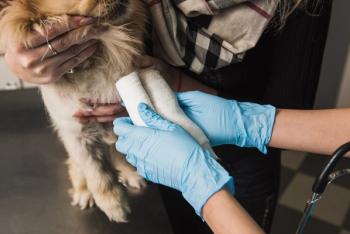
- Firstline March/April 2020
- Volume 16
- Issue 2
That's a wrap! Wound management tips for veterinary technicians and nurses
From getting the wrap just right to managing issues that confound healing to using new tools that promote healing, jump into the realm of wound care with gusto.
With bandaging being well within the scope of practice of a veterinary technician, wound management is a task commonly encountered in veterinary nursing. Here are a few tips to help you feel more confident addressing-and dressing-wounds in your patients.
Defining the-‘Ow!'-issue
Wounds are broadly defined as any damage to the skin and underlying structures, which can present as abrasions (less than full-thickness), lacerations (sharp skin edges), punctures (deep wounds through a small opening), degloving (skin and tissues torn away), burns (heat-based damage of various thickness), and decubital ulcers (compression injury). Management of each type varies depending on severity, degree of contamination, mechanism of injury, time since injury and location. Each wound requires a patient-specific approach, which makes accurate history-taking vital.
The goal: Aid healing without pain or infection
Wound healing can be optimized by maximizing factors that improve tissue perfusion while minimizing factors that delay healing. Assessing the patient's general perfusion status and paying attention to blood supply to the wound will help with delivery of vital oxygen and therapeutics such as antimicrobials. Minimizing contamination and damage to tissues will increase chances of successful healing. Proper techniques in lavaging and débriding tissues, aseptic technique and proper dressing and bandaging to provide a barrier are important. Take care in bandaging to prevent unnecessary pressure points and include strategies to prevent hematomas and seromas that could increase pressure on wound beds and provide dead space encouraging bacterial growth.
Treat the patient, not just the wound
Factors such as cancer and chemotherapy, chronic corticosteroid use, Cushing's disease, diabetes, kidney disease, liver disease, pain and malnutrition are known to make wound healing difficult. Always consider controllable factors of the patient to aid healing. The use of systemic corticosteroids should be avoided, and any immunocompromising disease should be treated. Nutrition is a commonly underappreciated aspect of patient care. Adequate nutrition will ensure wound repair optimization. Stress and pain can increase sympathetic tone and increase glucocorticoid release, which impairs healing. Hypothermia can also delay healing. The combination of a well-treated wound and patient is necessary for optimal healing and prevention of infections.
Sweet! Unique tools in wound healing
Topical application of high-osmolarity substances can help draw water and lymph to the wound surface, providing nutrition for the wound. Sugar and honey are commonly used for this effect. They also have some antibacterial effect and enhance tissue growth and epithelialization. In addition, honey is acidic (pH of about 3.6) and contains hydrogen peroxide, which helps decrease bacterial growth. Unpasteurized honey seems to have better effects than pasteurized, with Manuka honey particularly being suggested as having superior effects. Other unique options, while they may require more extensive research before you use them, include
Become a specialist!
Wound management is a topic that crosses several specialties. It's primarily within the domain of surgery, with the
Kenichiro Yagi practices at Adobe Animal Hospital in California as an ICU and Blood Bank Manager. He is co-chair of the Veterinary Nurse Initiative and serves as a board member of the Veterinary Emergency and Critical Care Society, the Academy of Veterinary Emergency and Critical Care Technicians and the Veterinary Innovation Council.
Articles in this issue
about 6 years ago
When the hospital owner undermines your leadershipabout 6 years ago
Clearing up cannabis confusion for veterinary professionalsabout 6 years ago
3 ways veterinary professionals can reframe negative thinkingabout 6 years ago
Pledge to be a veterinary superheroNewsletter
From exam room tips to practice management insights, get trusted veterinary news delivered straight to your inbox—subscribe to dvm360.






